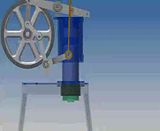My don't delete me post
-
kaltblutig
- Posts: 12
- Joined: Sat Aug 20, 2011 9:11 pm
My don't delete me post
Hi all.
My name is Mark and I live in Grand rapids Michigan.
I recently "discovered and unfinished Stirling engine project and I am in the process of completing it. It appears to be a 1/4-1/3 scale model of an Ericsson Hot air engine. Not sure exactly what the history of it is, but it appears to be someone's attempt to recreate one of the 1/4 scale models from Myers Engine Works. It is missing some parts however and I will need to fabricate these. The displacer piston and heater cylinder head are not there and I have done a few calculations in order to attempt to find the correct size for these. The power piston is there, as is it's operating mechanism and the mechanism for the displacer.
Here's my calculations:
Power piston diameter= 2.025" (measured, aluminum)
Power piston stroke=1" (measured)
Displacer chamber diameter=2.026" (measured)
Displacer piston stroke=2.4375" (measured)
Length of displacer chamber=3*2.026=6.0078"
Heated length of displacer chamber=2/3*6.078=4.052"
Cooled length of displacer chamber=1/3*6.078=2.026"
Displacement of power piston(swept volume)=1.013^2*Pi*1=3.976 in^3
Displacement of displacer piston(swept volume)=3/2*3.976=5.964 in^3
Displacer length=2/3*6.078=4.052"
Displacer stroke=1/3*6.078=2.026" (note: does not match actual stroke)
Displacer volume/power piston volume=6.53/3.98=1.64:1
Can anyone confirm my calculations?
The issue i am having is that most of the images i see of these models have a fairly significant length of heater extending into the fire box below the base. My calculations would put the displacer much higher up into the cylinder with only a small heater cylinder head extending down into the firebox.
Also I have been trying to determine the proper clearance between the displacer and the cylinder walls. I have read that 1/2mm for the side wall clearance is the guideline, but i am concerned about the displacer hitting the sidewall if run that tight. My though was to increase this to 1mm, but then concern is deadspace. A 1mm gap would correspond to 12% deadspace by my calculation. I also worry about the spacing at the end of the cylinder. I would assume that a complete evacuation of the cylinder would be the most beneficial, but the suggested guideline seems to be 1/4" clearance. This would add another 12% deadspace. 24% deadspace seems like a lot to me.
Any advice would be appreciated. I am not necessarily looking to make maximum power out of the unit, I just need it to run well enough that I can measure the output.
Anyway, nice to meet you all and thanks in advance for any response.
My name is Mark and I live in Grand rapids Michigan.
I recently "discovered and unfinished Stirling engine project and I am in the process of completing it. It appears to be a 1/4-1/3 scale model of an Ericsson Hot air engine. Not sure exactly what the history of it is, but it appears to be someone's attempt to recreate one of the 1/4 scale models from Myers Engine Works. It is missing some parts however and I will need to fabricate these. The displacer piston and heater cylinder head are not there and I have done a few calculations in order to attempt to find the correct size for these. The power piston is there, as is it's operating mechanism and the mechanism for the displacer.
Here's my calculations:
Power piston diameter= 2.025" (measured, aluminum)
Power piston stroke=1" (measured)
Displacer chamber diameter=2.026" (measured)
Displacer piston stroke=2.4375" (measured)
Length of displacer chamber=3*2.026=6.0078"
Heated length of displacer chamber=2/3*6.078=4.052"
Cooled length of displacer chamber=1/3*6.078=2.026"
Displacement of power piston(swept volume)=1.013^2*Pi*1=3.976 in^3
Displacement of displacer piston(swept volume)=3/2*3.976=5.964 in^3
Displacer length=2/3*6.078=4.052"
Displacer stroke=1/3*6.078=2.026" (note: does not match actual stroke)
Displacer volume/power piston volume=6.53/3.98=1.64:1
Can anyone confirm my calculations?
The issue i am having is that most of the images i see of these models have a fairly significant length of heater extending into the fire box below the base. My calculations would put the displacer much higher up into the cylinder with only a small heater cylinder head extending down into the firebox.
Also I have been trying to determine the proper clearance between the displacer and the cylinder walls. I have read that 1/2mm for the side wall clearance is the guideline, but i am concerned about the displacer hitting the sidewall if run that tight. My though was to increase this to 1mm, but then concern is deadspace. A 1mm gap would correspond to 12% deadspace by my calculation. I also worry about the spacing at the end of the cylinder. I would assume that a complete evacuation of the cylinder would be the most beneficial, but the suggested guideline seems to be 1/4" clearance. This would add another 12% deadspace. 24% deadspace seems like a lot to me.
Any advice would be appreciated. I am not necessarily looking to make maximum power out of the unit, I just need it to run well enough that I can measure the output.
Anyway, nice to meet you all and thanks in advance for any response.
Re: My don't delete me post
Hi,
I have no idea about the sizing of parts, I just wanted to welcome you and wish you the best of luck. I love those engines and don't understand why it's such a big deal to get someone (not me) to build these engines (to full size) with modern materials.
R
I have no idea about the sizing of parts, I just wanted to welcome you and wish you the best of luck. I love those engines and don't understand why it's such a big deal to get someone (not me) to build these engines (to full size) with modern materials.
R
Re: My don't delete me post
kaltblutig, as a general rule the volume of the displacer cylinder is a little greater than that of the power cylinder to the ratio of 1.5: 1, a little more might not hurt too much. The displacer should be about three times its diameter in length, and a gap of 1/16"would be good, and I would go for 1/8" top and bottom, ie., length of displacer plus stroke plus clearance gives the length of the cylinder.
If you have a picture of a completed motor, you should be able to scale any parts from there. It should be a nice model, and well worth completing, and taking out and showing off. A little gas camp stove would be very handy for running the motor. Ian S C
If you have a picture of a completed motor, you should be able to scale any parts from there. It should be a nice model, and well worth completing, and taking out and showing off. A little gas camp stove would be very handy for running the motor. Ian S C
-
kaltblutig
- Posts: 12
- Joined: Sat Aug 20, 2011 9:11 pm
Re: My don't delete me post
Thanks for the responses guys.
Here's 2 animations of what I have so far. Everything is to scale. Please note the engine is running backwards.
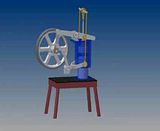
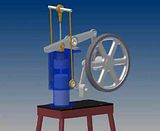
Clicking on the image should open the animation.
Here's a few pictures I found on the web of an actual engine and a model that looks nearly identical to what I have. the heated area seems to be significantly longer.
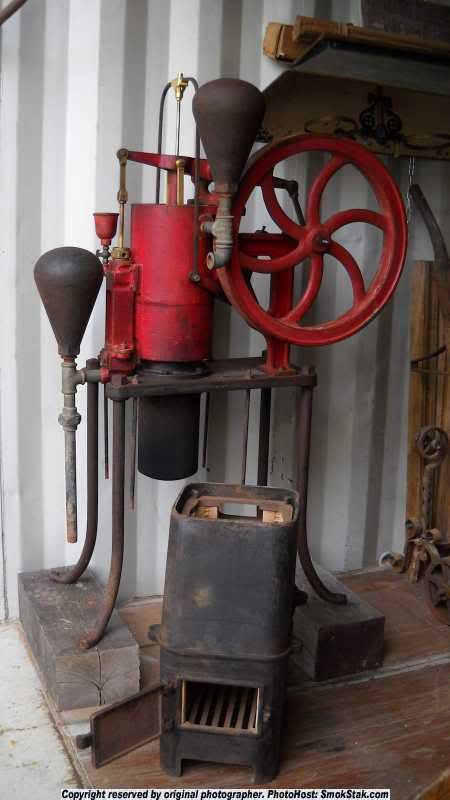
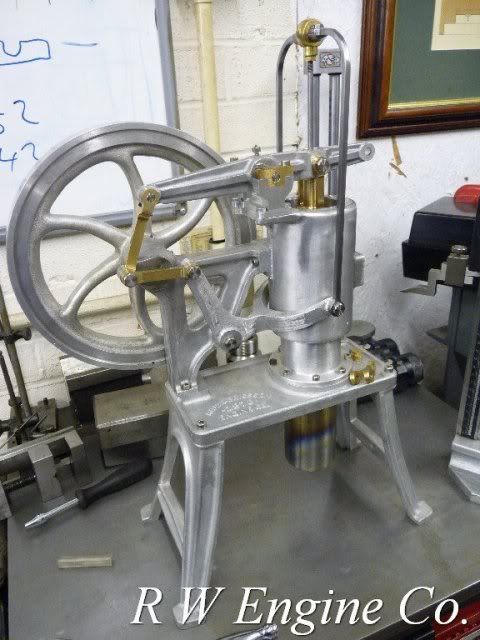
The heater chamber is obviously not in my animations, but would only extend about 2" past the base plate.
Here's 2 animations of what I have so far. Everything is to scale. Please note the engine is running backwards.


Clicking on the image should open the animation.
Here's a few pictures I found on the web of an actual engine and a model that looks nearly identical to what I have. the heated area seems to be significantly longer.


The heater chamber is obviously not in my animations, but would only extend about 2" past the base plate.
-
kaltblutig
- Posts: 12
- Joined: Sat Aug 20, 2011 9:11 pm
Re: My don't delete me post
I'm Ferraccio from Italy.
Compliments for your remarkable work, in materials and in images!
Before to give answer please a question: becouse this title for the discussion?
We have supported strange theory-men for many time, without delete. Property of delete is only in hands of Coordinator, and this operation is only for evident disturbs.
I personally think that we aren't able to redo calculations of yet built engine, as you well know, (sincerely I think you have "copied" your engine, and not "calculated") is a lot simpler draw-and-built on the basis on the existing engine, than to project "ex novo" and calculate it.
Is an engine with a beautiful aesthetic of 1800.
Instead I am more critical to its efficiency, and the engineering approach to buil: each lever that moves is really nice. but it's lost work, each pin wheel is friction, which reduces the power.
Briefly, the moving parts are nice, but most of the work ends simply there.
is an interesting work of industrial architecture.
Compliments for your remarkable work, in materials and in images!
Before to give answer please a question: becouse this title for the discussion?
We have supported strange theory-men for many time, without delete. Property of delete is only in hands of Coordinator, and this operation is only for evident disturbs.
I personally think that we aren't able to redo calculations of yet built engine, as you well know, (sincerely I think you have "copied" your engine, and not "calculated") is a lot simpler draw-and-built on the basis on the existing engine, than to project "ex novo" and calculate it.
Is an engine with a beautiful aesthetic of 1800.
Instead I am more critical to its efficiency, and the engineering approach to buil: each lever that moves is really nice. but it's lost work, each pin wheel is friction, which reduces the power.
Briefly, the moving parts are nice, but most of the work ends simply there.
is an interesting work of industrial architecture.
Re: My don't delete me post
.....and industrial archeology, the new one is somewhere else.
Re: My don't delete me post
We are interest to discuss about, if you like and have interest.
Re: My don't delete me post
I think you say the displacer is 4.025", I would suggest that this is a bit short, 6" is nearer the mark. In your diagram can the cylinder be arranged so that the water jacket is a little nearer to the top of the table, this also would lower thehot end, and the center of gravity (help to stop it falling over). Ian S C
Re: My don't delete me post
Ferraccio,Ferraccio wrote:I'm Ferraccio from Italy.
snip...
Is an engine with a beautiful aesthetic of 1800.
Instead I am more critical to its efficiency, and the engineering approach to buil: each lever that moves is really nice. but it's lost work, each pin wheel is friction, which reduces the power.
Briefly, the moving parts are nice, but most of the work ends simply there.
is an interesting work of industrial architecture.
Yes yes you have a point, but you are missing something vital here. The following is not entirely directed at you, so please don't take offense.
The Rider-Ericsson engines were actually produced and they actually did measurable work. I know of no such Stirling engine that is on the market today, or at least any that are available in the USA. Many of us here have built models that run, and some of them are quite nice, but how much work can they produce? Little to none. Maybe drive an LED or two and that's it. If I'm wrong about the public availability I'd like to know where to go and buy one.
I would buy a reproduction of the 8" Rider-Ericsson today if one were available. With modern materials and construction methods these engines could last a very long time and supply power for a great many applications. These simple engines would be easy for anyone with a basic mechanical ability to repair and or maintain, whereas some of the newer designs I see, but can't buy, need a specialist to keep running.
I really don't care if a percentage of the power is parasitic to the running of the engine. What I care about is that the engine can do something besides sit on the table looking cute.
Lately I've read on our forum how this theoretical ideal must be reached, that a specific material is the only suitable one for a given application or one objection after another until actually building a power producing engine is out of reach of most here. If we take a different approach and start with a proven design and build on that we will have made much more progress than arguing about stuff that doesn't matter to the average Joe.
That's my rant for the day, and thanks for reading,
RS
Re: My don't delete me post
Thank you for your comment that allows me to agree with you, make my comments. and give you my conclusions, that I think affect you, but also others.
I agree with you that many involved in the usual engines "wire and tin cans", or nearly so, and do not make engines that produce a little work "measured".
When I addressed to the problem "Stirling" I have documented, talking to friends of the forum, then I read the book of Andy Ross, "Making Stirling engines", available on the web through Jimlarsen, all this in the light of my knowledge of the designer .
I examined the difference in energy yield of different architectures (alpha, beta and gamma).
I have examined the effect on yields with the pressurization, and resulting complications in structural (to design equipment under pressure was my job).
Then I applied my knowledge, and those that emerged from the data studied, to find solutions to reduce friction, promote heat exchange, and produce the insulation where it should.
Results:
(My results are estimated) I designed on paper, but my conclusions are (I think) rather close to the truth.
For an engine "wire and cans" that produces 2 W,
If built with technology that works displacer as regenerator, and cooler finned simply, the power can be 8 W.
With hot-head technology for internal fins, nickel thin foil as regenerator, fins surface exchanger for the cooler, and water jacket: the power can be 50 W,
When the engine is pressurized to 15 atm the same engine capacity can produce 750 W
We always speak of the air motor, if it is helium or hydrogen engine, the engine can produce with the same cylinder more than twice, if we consider the architecture: the alpha produces 30-60% more of beta and gamma (reducing dead space).
Conclusions:
Has no sense to design a Stirling engine that produces energy appreciably without addressing "high technology" and pressurization.
Try to do as I did, you and I realize, these are NOT my beliefs, are facts.
In 1800 they produced precisely machinery to produce 2500 W that weighed three hundred pounds.
This largely explains BECOUSE today quite all Stirling engines built by "amateur" are simple, and none addresses the issue of power, and why those who have developed, a high price, for the right technologies are careful not to publish them.
If you want to look simple and easy engines, with low maintenance I suggest you look at the Lister engine, and Indian Listeroids.
If you want a Stirling engine, and also talk about power, and energy that must be measured, you have to go up in the machining of grooves 1/30 of an inch, tolerances of 1/2000" and the use of nickel and stainless steels, sorry.
Of course I'm allowable to discuss about this with you, and to all that like.
Ferraccio
I agree with you that many involved in the usual engines "wire and tin cans", or nearly so, and do not make engines that produce a little work "measured".
When I addressed to the problem "Stirling" I have documented, talking to friends of the forum, then I read the book of Andy Ross, "Making Stirling engines", available on the web through Jimlarsen, all this in the light of my knowledge of the designer .
I examined the difference in energy yield of different architectures (alpha, beta and gamma).
I have examined the effect on yields with the pressurization, and resulting complications in structural (to design equipment under pressure was my job).
Then I applied my knowledge, and those that emerged from the data studied, to find solutions to reduce friction, promote heat exchange, and produce the insulation where it should.
Results:
(My results are estimated) I designed on paper, but my conclusions are (I think) rather close to the truth.
For an engine "wire and cans" that produces 2 W,
If built with technology that works displacer as regenerator, and cooler finned simply, the power can be 8 W.
With hot-head technology for internal fins, nickel thin foil as regenerator, fins surface exchanger for the cooler, and water jacket: the power can be 50 W,
When the engine is pressurized to 15 atm the same engine capacity can produce 750 W
We always speak of the air motor, if it is helium or hydrogen engine, the engine can produce with the same cylinder more than twice, if we consider the architecture: the alpha produces 30-60% more of beta and gamma (reducing dead space).
Conclusions:
Has no sense to design a Stirling engine that produces energy appreciably without addressing "high technology" and pressurization.
Try to do as I did, you and I realize, these are NOT my beliefs, are facts.
In 1800 they produced precisely machinery to produce 2500 W that weighed three hundred pounds.
This largely explains BECOUSE today quite all Stirling engines built by "amateur" are simple, and none addresses the issue of power, and why those who have developed, a high price, for the right technologies are careful not to publish them.
If you want to look simple and easy engines, with low maintenance I suggest you look at the Lister engine, and Indian Listeroids.
If you want a Stirling engine, and also talk about power, and energy that must be measured, you have to go up in the machining of grooves 1/30 of an inch, tolerances of 1/2000" and the use of nickel and stainless steels, sorry.
Of course I'm allowable to discuss about this with you, and to all that like.
Ferraccio
Re: My don't delete me post
Look at GENOASTIRLING.
Modern materials, modern bearings proberbly double the power of the equivalent 19th century motor.
Not really related, I do some work at a local museum where we have an old water turbine, the rotor is about 30" in diameter,producing about 3hp with a 16ft head. I'v been told that with modern materials a turbine about a foot in dia would give about the same power, the revs on the new turbine would be much higher, the old one runs at a little over 120rpm (just out of interest the drive is via a pair of bevel gears, the one on the turbine shaft has wooden teeth, while the driven gear is cast iron, these gears are 30" in dia). Ian S C
Modern materials, modern bearings proberbly double the power of the equivalent 19th century motor.
Not really related, I do some work at a local museum where we have an old water turbine, the rotor is about 30" in diameter,producing about 3hp with a 16ft head. I'v been told that with modern materials a turbine about a foot in dia would give about the same power, the revs on the new turbine would be much higher, the old one runs at a little over 120rpm (just out of interest the drive is via a pair of bevel gears, the one on the turbine shaft has wooden teeth, while the driven gear is cast iron, these gears are 30" in dia). Ian S C
Re: My don't delete me post
Genoastirling is an initiative born near Genoa University few miles to my home, but now trasferred to Milan (Milano).
I do not know the engineers.
The engines (clearly prototypes) are well designed, but in order of informations contained in the Ross book, and for my esperience shoul be improved.
An engine as the Genoastirling: mini tubes on the heat, thin finning in the cooler, may be nickel or stainless gauzes for regenerator, in parity of displacement and heat supplied may produces from 3 to six more than 1800 engine.
No comparation about weights.
Fer
I do not know the engineers.
The engines (clearly prototypes) are well designed, but in order of informations contained in the Ross book, and for my esperience shoul be improved.
An engine as the Genoastirling: mini tubes on the heat, thin finning in the cooler, may be nickel or stainless gauzes for regenerator, in parity of displacement and heat supplied may produces from 3 to six more than 1800 engine.
No comparation about weights.
Fer
Re: My don't delete me post
I see that of the engines on the GENOASTIRLING site the first three are for saleranging upward from 8,000E. the power outputfor the five sizes is .35Kw, 1Kw, 3Kw, 5Kw, 7Kw, the last two will be available over the next two years. They appear to be BETTA type motors, the little one is single cylinder, the rest are two cylinder, and I would say that a motor built that way could be extended to three or four cylinder, each cylinder is its own motor. Its good to see that a usefull little motor is available. Ian S C
Re: My don't delete me post
Ian,
The engine is not beta, is a gamma with parallel pistons/displacer (the beta is strictly coaxial, there you have problem on friction and lubrication coaxial stems ans also complication in leverages).
(The difference alpha against "beta-gamma" is that in the first the working pressure is always "upside" (the displacer and piston), in the other the working pressure is also also in variable volume "downside" the displacer, this increase dead spaces.
Andy Ross (described in its book) built all engines, (except the first), in alpha architecture (!).
The Genoastirling (in pictures) are clearly prototypes, (still need to start somewhere!!!), well built OK, but protypes.
The terms of sale clearly indicates that at this stage the engine is sold as a demo use, (probably the pieces are not manufactured in series).
The drawings are indicative only, (of course!!!) some details (as I seen) may be are to be improved, or are yet improved-modified.
Is good idea of genoastirling use the one cylinder as a module for twoo or three unit (is obvious!!); for four-units may be is good a different structure "in circle" yet seen in the forum.
The work of Genoastirling is however remarkable, (in Italian: let us take off our hats).
The difference with '800 engine, considering "as done" all different elements (is not well clear in drawings) as structure of internal fins (good heat exchange), tickness of walls (good heat flow), semplification of cranks (minor mass to move), abolition of so nice knees in moving (less friction and weigh), I think may be reached ten-twelve time the power, (without pressurizing), take care that the genoastirlin is burdened by the fact that it is expected as pressurized, the walls with modern materials may a lot thinner, with better heat exchange.
Fer
The engine is not beta, is a gamma with parallel pistons/displacer (the beta is strictly coaxial, there you have problem on friction and lubrication coaxial stems ans also complication in leverages).
(The difference alpha against "beta-gamma" is that in the first the working pressure is always "upside" (the displacer and piston), in the other the working pressure is also also in variable volume "downside" the displacer, this increase dead spaces.
Andy Ross (described in its book) built all engines, (except the first), in alpha architecture (!).
The Genoastirling (in pictures) are clearly prototypes, (still need to start somewhere!!!), well built OK, but protypes.
The terms of sale clearly indicates that at this stage the engine is sold as a demo use, (probably the pieces are not manufactured in series).
The drawings are indicative only, (of course!!!) some details (as I seen) may be are to be improved, or are yet improved-modified.
Is good idea of genoastirling use the one cylinder as a module for twoo or three unit (is obvious!!); for four-units may be is good a different structure "in circle" yet seen in the forum.
The work of Genoastirling is however remarkable, (in Italian: let us take off our hats).
The difference with '800 engine, considering "as done" all different elements (is not well clear in drawings) as structure of internal fins (good heat exchange), tickness of walls (good heat flow), semplification of cranks (minor mass to move), abolition of so nice knees in moving (less friction and weigh), I think may be reached ten-twelve time the power, (without pressurizing), take care that the genoastirlin is burdened by the fact that it is expected as pressurized, the walls with modern materials may a lot thinner, with better heat exchange.
Fer
